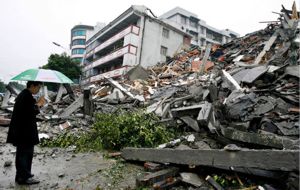
Home Security: Earthquake Safety
An earthquake is a seismic event marked by the sudden movement of tectonic plates, or large sections of the Earth's crust. The effects of an earthquake include the potential violent shaking of the ground and the visible shifting of land, which may cause cracks to appear in the ground along the fault line. Earthquakes are among the most frightening of natural disasters, particularly because they are all but impossible to predict. When they occur, the ground itself becomes a force of destruction, shaking everything that rests upon it. Whole cities can be ravaged or even destroyed by earthquakes, like San Francisco in 1906 and the country of Haiti in 2010. Moreover, additional earthquakes known as aftershocks can occur repeatedly in the same area.
While some areas around the world are more prone than others to earthquakes, almost all are susceptible to a seismic event at some point in time. Some earthquakes occur along previously undetected faults, such as the case of the devastating 2010 quake in Haiti. Since there is no advanced warning for an earthquake, the best plan for survival is to prepare ahead of time. Like other natural disasters, earthquake preparedness planning involves steps that one must take to prepare for a future occurrence, as well as plan for how to react when it occurs, and how to survive in the aftermath. Even in an area where earthquakes aren't known to happen, it is wise to prepare in advance and understand how to react.
Preparedness Before an Earthquake
The most important part of responding to an earthquake is to prepare ahead of time. The path to preparedness begins with educating the household about what to do in the event of a quake, as well as where to assemble in case people get separated. Earthquake response drills are a necessary part of preparedness. Everyone should know how to shut off the gas to the house, as well as the electricity, to prevent explosions, electrocution or fires. The next step is to assemble a survival kit. The kit should typically contain a first aid kit, as well as a wrench and one or more durable flashlights that are designed to resist damage. A preparedness kit also needs to include a radio that uses batteries. It should also have a fresh supply of extra batteries to work with both the radio and flashlight. All furniture and appliances should be anchored, especially cabinets, refrigerators, bookcases, and other things that can fall over in the event of a quake. It will also be necessary to store several days' worth of canned, non-perishable food and bottled water. Every household should have one or more fire extinguishers, as well.
What to Do During an Earthquake
When an earthquake strikes, it happens without warning, and the time it takes for one to react is critical. When indoors, the first thing that a person should do is to drop to the ground. He or she should then seek cover under a sturdy object like a table or a desk, and then hold onto its legs to keep it overhead to act as a shield. Avoid running outside, as well as being near any windows, mirrors, overhanging light fixtures, or unsecured furniture. If an earthquake strikes while food is cooking in the kitchen, it is necessary to turn off all heating elements. If caught outside, one should not try to go inside, or move near a building or a tree. Avoid going onto bridges, near power lines, and beneath overpasses. People in cars should not try to escape, and drivers should get their car to a safe location out in the open, then stop.
After an Earthquake is Over
Family members should assemble immediately after a quake. Any fires should be put out, and utilities like water, electricity and gas should be shut off. This must be done even if there are no visible signs of danger. This is because certain types of gases are odorless and damaged wiring may not be easily detected. Tend to any injuries that might have occurred, and keep shoes on to avoid stepping on shards of glass or other hazards. Use the radio to listen for information and updates. Because earthquakes in certain areas around coastlines can lead to large tidal waves called tsunamis, those living along the coastline should move to higher ground.
This article was written by Mike Haldas, co-founder and managing partner of CCTV Camera Pros. If you found it useful, please share it.
| Shop for video surveillance products |
|---|
| | | |
|---|
|











